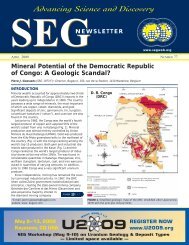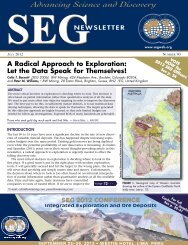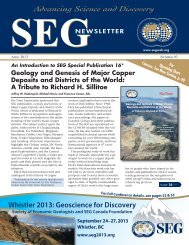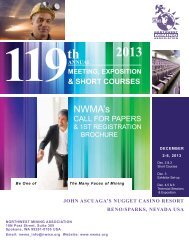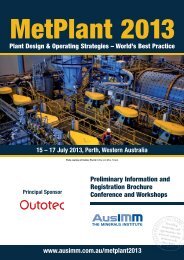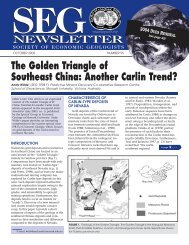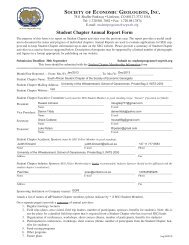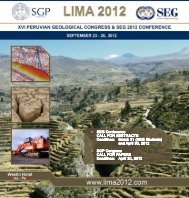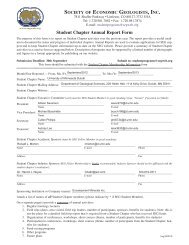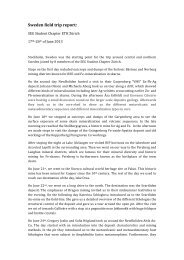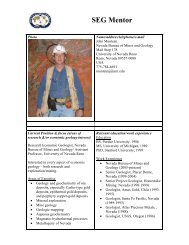SEG 45 Final_qx4 - Society of Economic Geologists
SEG 45 Final_qx4 - Society of Economic Geologists
SEG 45 Final_qx4 - Society of Economic Geologists
You also want an ePaper? Increase the reach of your titles
YUMPU automatically turns print PDFs into web optimized ePapers that Google loves.
32 <strong>SEG</strong> NEWSLETTER No 53 • APRIL 2003<br />
... from 31<br />
<strong>SEG</strong>-GAC-MAC Joint Spring Meeting 2003 (Continued)<br />
ANNOUNCEMENTS<br />
plutonic rocks and sedimentary rocks;<br />
new deposit and camp descriptions;<br />
regional semi-conformable to depositscale<br />
hydrothermal alteration; metal<br />
and fluid source tracing; timing <strong>of</strong> massive<br />
sulphide events; and models for ore<br />
deposition and genesis. Attendees interested<br />
in this session also will be<br />
attracted to field trips A1 and A2.<br />
SS10.<br />
TECTONIC CONTROLS ON PALEO-<br />
PROTEROZOIC MINERALIZATION<br />
Chris Beaumont-Smith<br />
(cbeaumont@gov.mb.ca),<br />
Alan Bailes (abailes@gov.mb.ca) and<br />
Alan Galley (agalley@NRCan.gc.ca)<br />
The Paleoproterozoic is one <strong>of</strong> the most<br />
prolific periods <strong>of</strong> early Earth history for<br />
production <strong>of</strong> base metal and gold mineralization.<br />
This session will present<br />
studies by researchers and explorationists<br />
on the setting and control <strong>of</strong> deposits<br />
formed during this important period<br />
including lode gold, volcanogenic massive<br />
Cu-Zn-Au sulphide, Olympic Damtype<br />
Cu-Au mineralization, and cratonmargin<br />
nickel and PGE mineralization.<br />
All aspects <strong>of</strong> these deposits will be considered<br />
including mine-scale studies,<br />
research into geological controls <strong>of</strong><br />
mineralization in individual mining<br />
areas, and studies emphasizing regionalscale<br />
tectonic-metallogenic controls.<br />
Attendees interested in this session also<br />
will be attracted to short course SC2 and<br />
field trips A1, A2, B1, and B2.<br />
SS11.<br />
GEM MATERIALS AND<br />
MINERALOGY<br />
Lee A. Groat (lgroat@eos.ubc.ca)<br />
SS12.<br />
APPLICATIONS OF GEOPHYSICAL<br />
INVERSION FOR MINERAL<br />
EXPLORATION: CURRENT STATUS<br />
AND VISION FOR THE FUTURE<br />
Douglas Oldenburg<br />
(doldenburg@eos.ubc.ca) and<br />
John McGaughey (johnm@<br />
mirageoscience.com)<br />
The last decade has seen large-scale<br />
advances in our ability to generate 3D<br />
physical property images <strong>of</strong> the Earth<br />
by inverting data from different geophysical<br />
surveys. With advanced visualization<br />
tools, these inversions allow new<br />
understanding about the geology at<br />
both regional and deposit scales. Today,<br />
geophysical inversions are carried out<br />
routinely by many companies and the<br />
inversions have been effective in finding<br />
mineral deposits and in reducing exploration<br />
costs. This session focuses on case<br />
histories that illuminate the impact that<br />
inversions have had on mineral exploration<br />
programs and also present a<br />
vision for future capabilities. Attendees<br />
interested in this session also will be<br />
attracted to the <strong>SEG</strong> workshop (WS1)<br />
Understanding Geophysical Inversions for<br />
Mineral Exploration.<br />
SS13.<br />
CANADIAN DIAMOND DEPOSITS:<br />
HISTORY AND TECHNIQUES<br />
OF THEIR DISCOVERY –<br />
A TRIBUTE TO HUGO DUMMETT<br />
Felix Kaminsky<br />
(felixvkaminsky@cs.com)<br />
and Donald K. Mustard<br />
(amustard@attcanada.net)<br />
The past decade has seen Canada move<br />
into the select ranks <strong>of</strong> diamond producing<br />
nations. This session consists <strong>of</strong><br />
contributions on all aspects <strong>of</strong> diamond<br />
exploration especially the research techniques<br />
employed in their discovery. The<br />
session is focused on the Canadian diamond<br />
scene, but contributions on diamond<br />
deposits from other geographical<br />
regions are considered. The session is a<br />
tribute to the late <strong>SEG</strong> president Hugo<br />
Dummett, a pioneer in diamond exploration<br />
and mine development in Canada.<br />
Attendees interested in this session also<br />
will be attracted to the <strong>SEG</strong> workshop<br />
(WS1) Understanding Geophysical<br />
Inversions for Mineral Exploration.<br />
SS14.<br />
NEW PERSPECTIVES ON THE<br />
EVOLUTION OF THE PLATINUM<br />
GROUP ELEMENTS IN MAGMAS<br />
AND ORE DEPOSITS<br />
James Scoates (jscoates@eos.ubc.ca)<br />
and David Peck<br />
(dpeck@angloamerican.ca)<br />
This special session brings together specialists<br />
in the mineralogy and geochemistry<br />
<strong>of</strong> platinum group elements (PGE)<br />
and geologists who study the field and<br />
structural aspects <strong>of</strong> PGE mineralization<br />
to address advances in our understanding<br />
<strong>of</strong> PGE evolution in magmas and<br />
ore deposits. Some <strong>of</strong> the areas <strong>of</strong><br />
progress in recent years include:<br />
increasingly sensitive analytical techniques<br />
for PGE, the recognition <strong>of</strong><br />
dynamic processes as important for PGE<br />
mineralization, and the development <strong>of</strong><br />
sophisticated physical and chemical<br />
models for PGE variations in basaltic to<br />
komatiitic magmas. Contributions<br />
related to these and other aspects <strong>of</strong><br />
magmatic PGE evolution and mineralization<br />
are considered. Attendees interested<br />
in this session also will be<br />
attracted to short course SC2 and field<br />
trip B2.<br />
SS15.<br />
ORE-FORMING PROCESSES IN THE<br />
PORPHYRY COPPER (GOLD) AND<br />
EPITHERMAL GOLD ENVIRONMENTS:<br />
WHAT DO WE REALLY KNOW?<br />
Stephen Rowins (srowins@eos.ubc.ca)<br />
and Anthony Williams-Jones<br />
(willyj@eps.mcgill.ca)<br />
It has become increasingly apparent<br />
that both high- and low-sulphidation<br />
epithermal gold deposits are, in many<br />
cases, genetically related to large porphyry<br />
copper-gold systems. These<br />
genetic linkages, however, are incompletely<br />
understood - a point underscored<br />
by the recent flood <strong>of</strong> analytical, experimental,<br />
theoretical, and field studies<br />
which call into question many <strong>of</strong> the<br />
assumptions commonly held regarding<br />
ore-forming processes in the porphyryepithermal<br />
environment. This special<br />
session highlights analytical, theoretical,<br />
experimental and field investigations<br />
<strong>of</strong> the mobility, transport, deposition,<br />
and source <strong>of</strong> metals in the<br />
porphyry-epithermal environment.<br />
Attendees interested in this session also<br />
will be attracted to short courses SC1<br />
and SC2 and field trips A2 and B1.<br />
SS16.<br />
CUTTING EDGE EXPLORATION<br />
TECHNIQUES FOR CONCEALED<br />
ORE DEPOSITS<br />
Ron Britten<br />
(rbritten@firstpointminerals.com)<br />
and Dick Tosdal (rtosdal@eos.ubc.ca)<br />
The discovery <strong>of</strong> new mineral deposits is<br />
becoming more challenging as near<br />
surface deposits are depleted. This<br />
session highlights exploration techniques<br />
that encompass various disciplines<br />
including geology, geochemistry,<br />
geophysics, and computer-aided visualization,<br />
which aid in the search for



